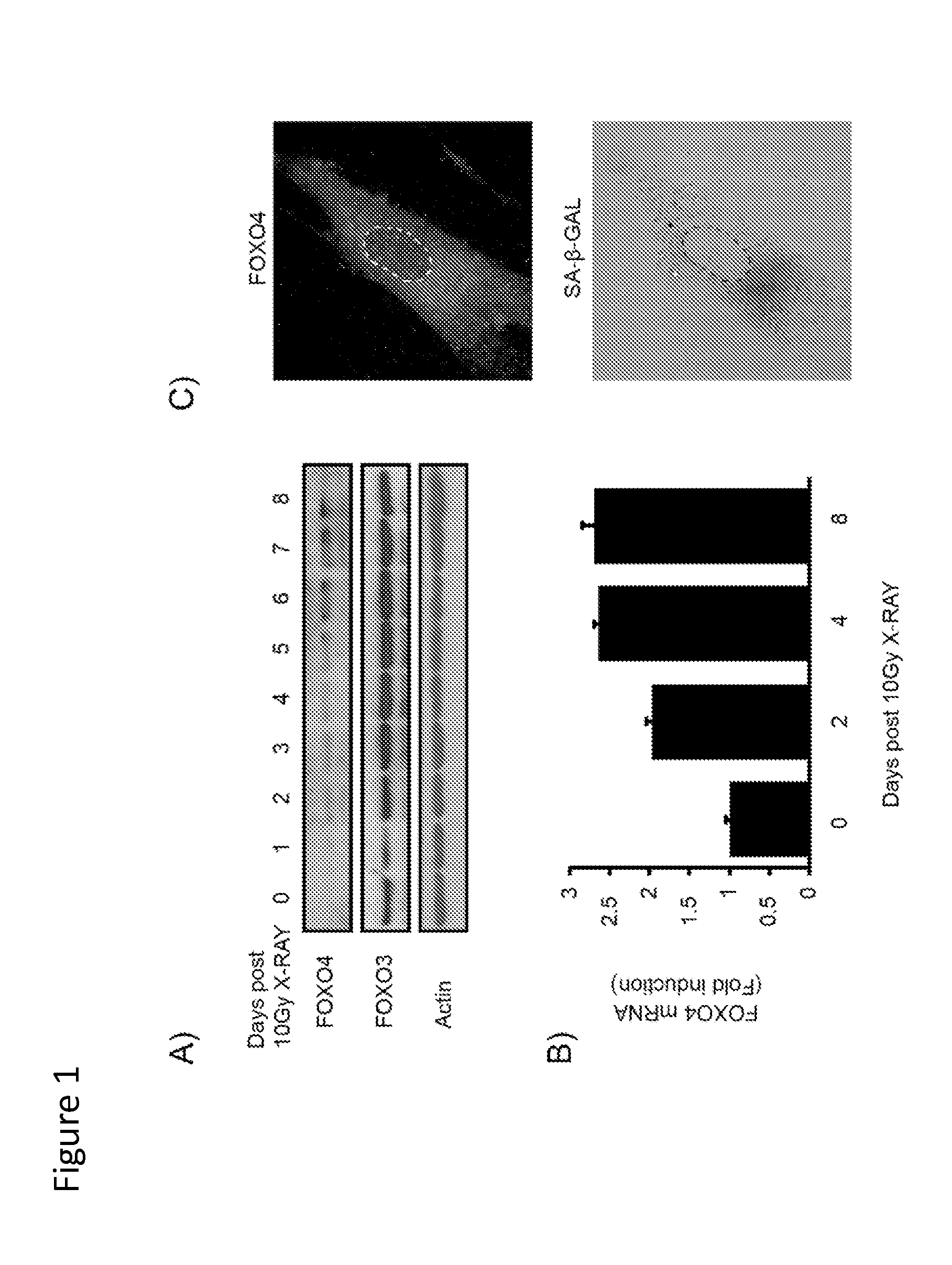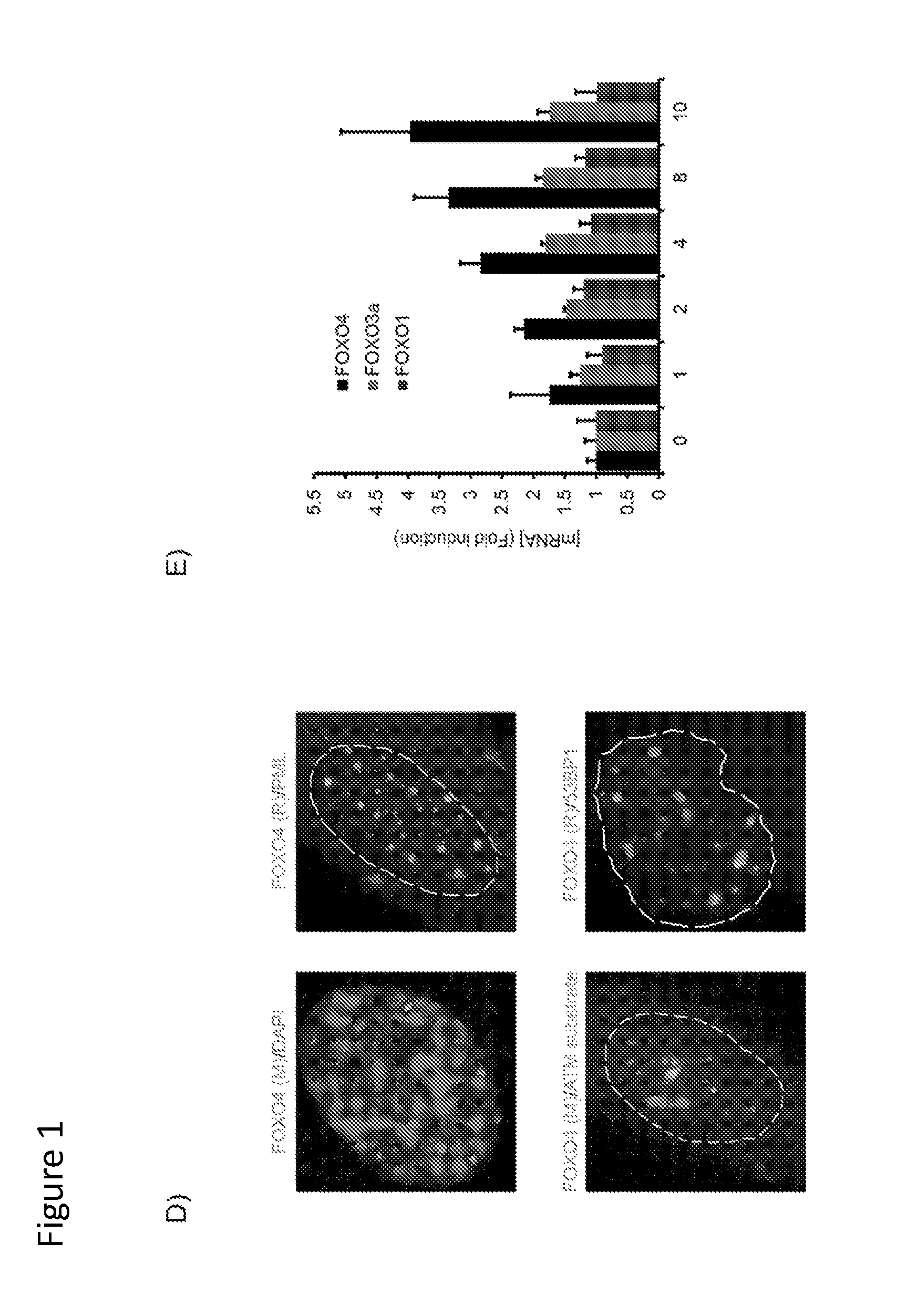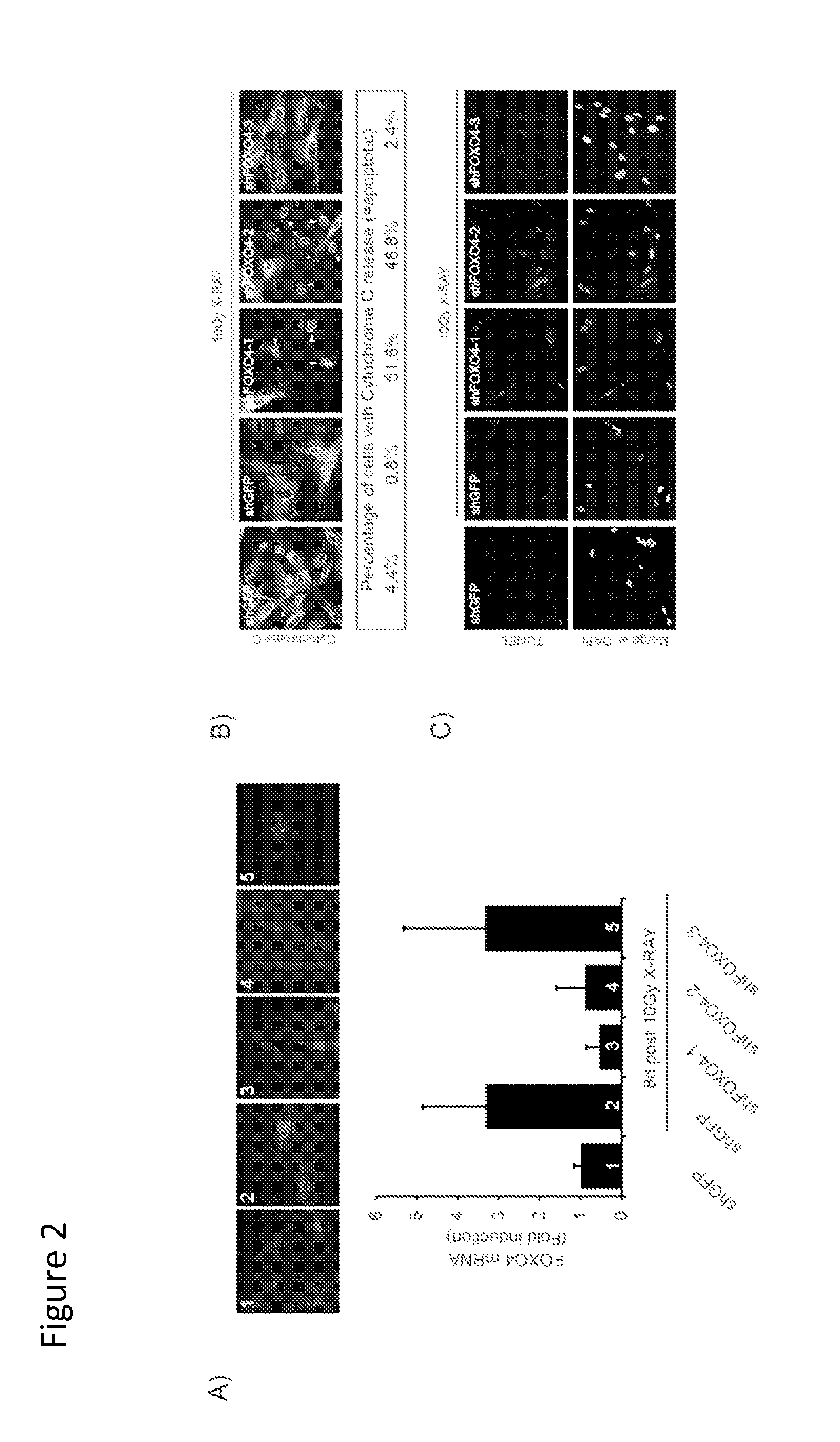Targeting senescent and cancer cells for selective killing by interference with foxo4
a technology of foxo4 and senescent cells, applied in the direction of peptide/protein ingredients, peptide sources, drug compositions, etc., can solve the problems of inefficient processing, achieve the effect of facilitating entry into a cell, facilitating entry of peptides into a cell, and facilitating entry
- Summary
- Abstract
- Description
- Claims
- Application Information
AI Technical Summary
Benefits of technology
Problems solved by technology
Method used
Image
Examples
example 1
Studying the Roles of FOXO4 in Apoptosis
[0099]This example describes one method to interfere with the survival of (A) senescent and (B) cancer cells by forcing a shift in their response to stress toward apoptosis.
[0100]FOXO4 is a molecular pivot that decides whether damaged cells undergo senescence or apoptosis. Some references state that it is unclear why some cells undergo apoptosis whereas others enter senescence in response to identical stimuli. FOXO transcription factors are negatively regulated by growth factor signaling, but, as we and others have shown, they can also be activated by oxidative stress (Brunet, A. et al., Science 303, 2011-2015 (2004); de Keizer, P. L. et al., Cancer Res 70, 8526-8536 (2010); Essers, M. A. et al., EMBO J. 23, 4802-4812 (2004)). Constitutive foxo1− / − mice are embryonic lethal and foxo3− / − mice show reproductive deficiencies, foxo4− / − mice do not harbor a significantly defective phenotype (Hosaka, T. et al., Proc.Natl.Acad.Sci.U.S.A 101, 2975-298...
example 2
Making FOXO4 Blocking Peptides
[0126]The amino acid sequence of human FOXO4 is shown as follows (SEQ ID NO:1):
MDPGNENSATEAAAIIDLDPDFEPQSRPRSCTWPLPRPEIANQPSEPPEVEPDLGEKVHTEGRSEPILLPSRLPEPAGGPQPGILGAVTGPRKGGDSNSSAGWKNSIRHNLSLHSKFIKVHNEATGKSSWWMLNPEGGKSGKAPRRRAASMDSSSKLLRGRSKAPKKKPSVLPAPPEGATPTSPVGHFAKWSGSPCSRNREEADMWTTFRPRSSSNASSVSTRLSPLRPESEVLAEEIPASVSSYAGGVPPTLNEGLELLDGLNLTSSHSLLSRSGLSGFSLQHPGVTGPLHTYSSSLFSPAEGPLSAGEGCFSSSQALEALLTSDTPPPPADVLMTQVDPILSQAPTLLLLGGLPSSSKLATGVGLCPKPLEAPGPSSLVPTLSMIAPPPVMASAPIPKALGTPVLTPPTEAASQDRM NFEPDP
[0127]The DNA binding domain as defined in Greer, E. L et al. (Oncogene 24, 7410-7425 (2005)) is underlined. The peptides of which the sequence lies within this domain are called the DBD-peptides. Two amino acids (WG) which in the FOXO4 homolog FOXO3 show the largest NMR shift upon addition of recombinant p53 are bolded and underlined. The peptides of which then sequence is localized in the far c-terminus are called C-term peptides. This region contains the ...
example 3
Studies Using Additional Chemotherapeutic Agents
[0137]We have shown that A375-shFOXO4 melanoma cells are more sensitive than A375-shGFP melanoma cells to not only PLX4032 (from Roche), but also to RAF265 (from Novartis) and AZD6244 (from Astra-Zeneca) and Cisplatin. How plain A375 cells respond to these drugs in the presence of a mixture of the DBD and C-term peptides is studied. The experimental design is as follows: 2×104 A375 melanoma cells plated in triplicate in 96-well plate chambers. The next day the cells are incubated with or without a mixture containing the DBD2 peptide (sequence: GRKKRRQRRRPPPRKGGSRRNAWGNQSYAELISQAIESAPEKRLTL) and the C-tem2 peptide (Sequence: GRKKRRQRRRPPPQDLDLDMYMENLECDMDNIISDLMDEGEGLDF), or either peptide alone, in different concentrations in the presence or absence of PLX4032, RAF265, AZD6244 or Cisplatin. After 6 days the a CellTiter 96® AQueous One Solution Cell Proliferation Assay (MTS) is performed according to the manufacturer's instructions (Pro...
PUM
| Property | Measurement | Unit |
|---|---|---|
| temperature | aaaaa | aaaaa |
| temperature | aaaaa | aaaaa |
| pH | aaaaa | aaaaa |
Abstract
Description
Claims
Application Information
 Login to View More
Login to View More - R&D
- Intellectual Property
- Life Sciences
- Materials
- Tech Scout
- Unparalleled Data Quality
- Higher Quality Content
- 60% Fewer Hallucinations
Browse by: Latest US Patents, China's latest patents, Technical Efficacy Thesaurus, Application Domain, Technology Topic, Popular Technical Reports.
© 2025 PatSnap. All rights reserved.Legal|Privacy policy|Modern Slavery Act Transparency Statement|Sitemap|About US| Contact US: help@patsnap.com



